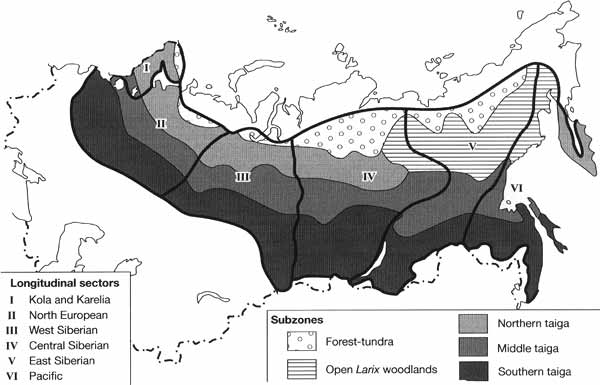Please put an active hyperlink to our site (www.rusnature.info) when you copy the materials from this page
Biomes and Regions of Northern Eurasia
Boreal Forests
<<< The Principal Forest-forming Species and
their Ecology | Biomes & Regions Index | Forest-tundra and Northern Open Forests >>>
The Major Zones and Sectors in the Taiga Biome
The composition of the coniferous forests changes in response to climatic factors,
topography, and permafrost conditions. The European territory has a relatively mild and
humid climate. Vegetated wetlands are extensive in European Russia. However, it is in
Western Siberia where the enormous areas of poor drainage have resulted in the formation
of the world's largest wetlands. Over 50 per cent of the lowland drained by the Ob is
subject to the formation of wetlands. In Central and Eastern Siberia, the extreme aridity
and dissected topography become major constraints in the development of wetlands. Few tree
species can tolerate the severity of climate and permafrost conditions which develop east
of the Yenisey river apart from Larix gmelinii. It forms vast monotypic stands in Central
and Eastern Siberia and the northernmost forests of Asia, which extend as far north as the
Taymyr peninsula and northern Sakha-Yakutia. The complexity and diversity of topography in
Eastern Siberia and the Pacific makes it difficult to define zonal vegetation.
Zonal differentiation is well expressed outside the mountainous areas. Three subzones
are distinguished within the taiga biome: northern, middle, and southern (Figure 9.2).

Fig. 9.2 Subzones and longitudinal sectors within the taiga zone
These subzones have distinct thermal regimes. Annual accumulated air temperatures
(using a daily mean of 10∞C as a reference temperature), an index often used to assess
thermal resources (see above), varies between 400-1200∞C in the northern taiga,
1200-1600∞C in the middle taiga, and 1600-2400∞C in the southern taiga.
Six longitudinal sectors are recognized within the subzones:
(I) Kola peninsula and Karelia, which belongs to the wider Scandinavian (Atlantic)
sector, dominated by Picea abies;
(II) North European, dominated by Picea abies and P. obovata;
(III) West Siberian where forests composed of Picea obovata, Abies sibirica, and Pinus
sibirica alternate with vast wetlands;
(IV) Central Siberian sector (between the Yenisey and the Lena) is dominated by Larix
gmelinii; forests composed of Picea obovata and Pinus sibirica occur in the southern and
westernmost regions, while Pinus sylvestris is common in the south;
(V) East Siberian with open Larix gmelinii forests and Pinus pumila;
(VI) Pacific sector.
Although the composition of the coniferous forests changes in response to climatic
factors, topography, and permafrost conditions, the floristic composition of the taiga
biome is rather uniform. The flora of the boreal coniferous forests includes about 2500
vascular plants with domination by Asteraceae, Poaceae, Cyperaceae, Brassicaceae,
Rosaceae, and Ranunculaceae families. Local floras (number of species per 100 km2)
contain between 350 and 400 species in the forest-tundra and open larch forest biomes,
400-500 species in the northern and middle taiga, and up to 700 species in the southern
taiga (Tolmachev, 1986; Tishkov, 1996). The majority of species are shade-tolerant and
cold-resistant and most have a shallow root system which develops under the moss cover.
<<< The Principal Forest-forming Species and
their Ecology | Biomes & Regions Index | Forest-tundra and Northern Open Forests >>>
Contents of the Boreal Forests section:
Other sections of Biomes & Regions:
|
|